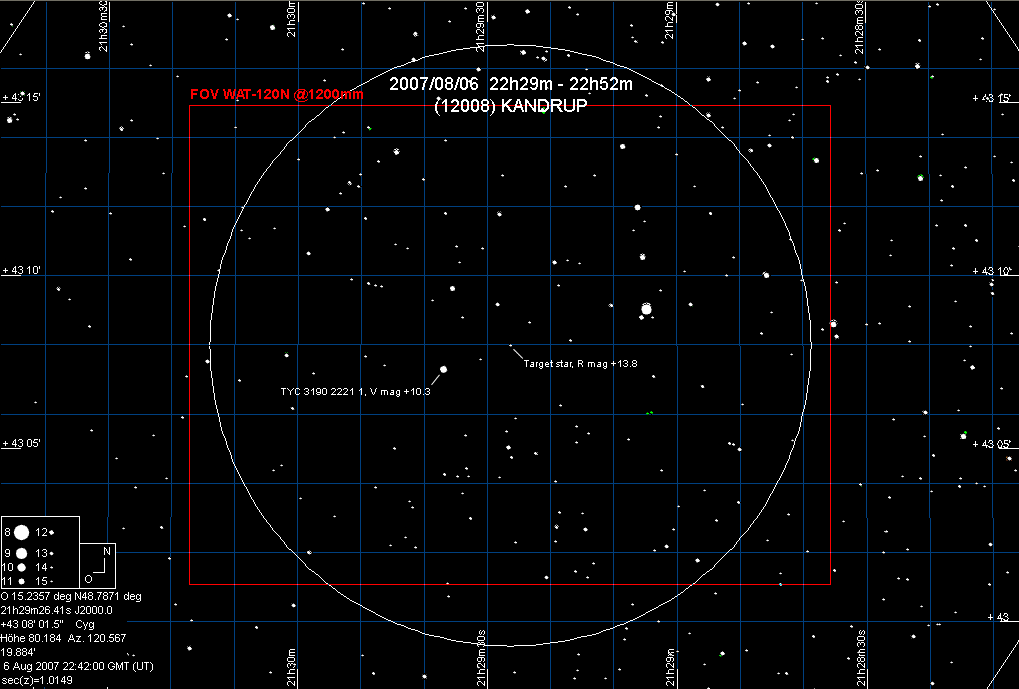| Starmap of Kandrup occultation on August 06, 2007 in Europe |
 Starmap created with Guide 8 from Bill J Gray |
| Frameless version of this page |
On July 25, 2007 the occultation observer community was informed by Jean Lecacheux (France) about star occultations caused by the probable close binary Mars-crosser and Mars 1:2 resonanter (12008) Kandrup. For more details read the postings on mailing list PLANOCCULT and on IOTAoccultations@yahoogroups.com.
This page was mainly made for user of integrating video cameras like the WAT-120N or other similar types used on telescopes with an aperture of 10 inches (254mm) or more. The goal was to show if it is possible to record the faint target star 2UCAC 46724470 on August 06, 2007 event in Europe with telescope apertures of 10 inches (254mm). But the results of this page still can be used also for other attempts of similar faint occultation recording.
12008 Kandrup occults star 2UCAC 46724470 on 2007 August 06 from 22h29m to 22h52m UTC
Star (2000): Mv = +13.8 mag
RA = 21 29 26.35
DEC = 43 08 02.26
| Starmap of Kandrup occultation on August 06, 2007 in Europe |
 Starmap created with Guide 8 from Bill J Gray |
Test records results
The test records were made in nearly similar conditions except the 38% lit moon in a distance of 75deg on August 06, 2007. But the influence of the moonlight can get one of the main factors for sucess or fail with a 10 inch aperture telescope.
Due to the expected binary system the maximal admissible video integration time should be about 1/3 second. So in CCIR (50 fields or 25 frames per second) 8 frames = 320ms would be the longest reasonable integration time. All my test records below were done with It=320ms (Mode 8x) and maximal gain of 38db. Only the Gamma setting on the camera WAT-120N and the playback settings in video software VirtualDub were altered. This details for every video record are inserted on every still video image below.
During all records only a clear class filter from Astronomik was used for CCD protection. I made also records without this filter but I could not see any remarkable change in star brightness.
Telescope system was a 254/1200mm Newton.
Observer: Gerhard Dangl
Date: 26/27 August 2007
Time: inserted by VTI
Position: 48 47 45 North
15 13 38 East
598m (all WGS84)
Test images
Conclusion:
Events like this are sure limiting events for a 10 Inch system. But it could be possible to take a useable record of this faint event with a 10 inch system and an integrating camera set to It=320ms. Weather, seeing conditions and moonlight will be essential about sucess or fail.
My favorite settings from above are camera WAT-120N to Gamma 0.45 (LO) and during playback in VirtualDub the use of a filter with setting brightness 0% and contrast 200%. Thereby I got a relativ stable star image during playback. And I assume a 1 mag drop would be definable within one 320ms integration sequence more precise within a time window of 100 to 150 ms.
| Video MPEG4 (2.1MB), It=320ms, Camera Gamma 0.45 (LO) VirtualDub - filter brightness 0% and contrast 200% |
I would recommend to evaluate a recorded video also complete manually (visual) beside the use of software like LiMovie or OccuLar.
30 July 2007 |
|
Site Home |